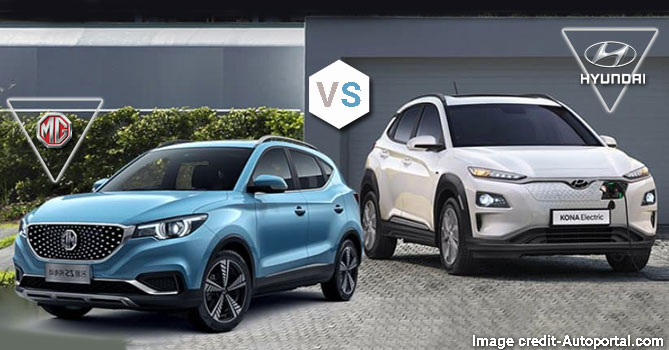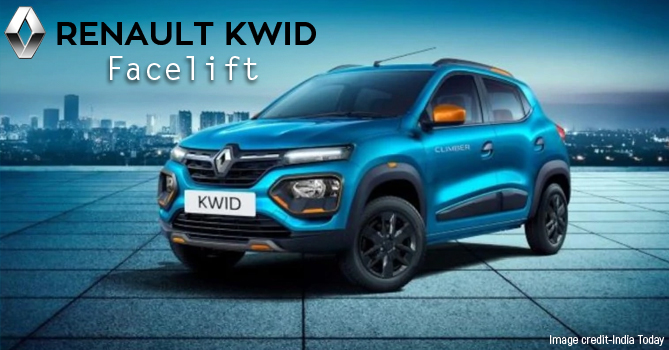
The Hector has laid some impressive groundwork for SAIC motor corp owned, British automaker Morris Garages. Post Hector’s successful debut and sales figures, they are patiently waiting for the right moment to make their Electric SUV, the MG ZS EV available for purchase. Launched earlier this year, the ZS is expected to go on sale in a few months from now.
It will be a direct rival to the Hyundai Kona Electric, with slightly bigger dimensions. The Kona has been better received than anticipated, and this is good news for MG, as it proves the potential of launching their electric vehicle in a market that’s started taking the first step towards sustainable mobility. That being said, it is the right time to make a comparative study between the MG ZS and the Hyundai Kona, to get a clear idea of their placement in the new-born electric hierarchy.
Size and Dimensions
The MG ZS EV is 134 mm longer, 9 mm wider and 50mm taller than the Hyundai Kona. Despite its larger dimensions, it is also surprisingly lighter than the Kona. The Kona, however, has shorter overhangs and hence gets a slightly longer wheelbase than the ZS.
Power – Output and Storage
The ZS is powered by a Permanent magnet synchronous motor, mated to a single-speed automatic transmission and front-wheel drive configuration. At an output of 143 horsepower, the ZS’s engine produces more power than the Kona but makes much less torque in comparison. The ZS is, however, capable of doing 0-100 kmph in 8.5 seconds, which is more than a whole second more than the Kona’s 9.7.
It comes with 44.5 kWh lithium-ion battery, that provides for a range of three hundred and forty kilometres, as certified by the Automotive research association of India. The battery can be charged up to eighty per cent using a fifty kilowatt DC fast-charger in less than an hour. The regular wall charger with a 7.4kWh output takes up to seven hours to charge the battery to a hundred per cent.
The Kona has a smaller battery as compared to the ZS with a 39.2 kWh power output and a full-charge travel-range of four hundred and fifty kilometres. It takes about an hour to make an eighty-per cent charge on a DC fast-charger, and up to six hours for a full charge on a 7.2kW wall-mounted unit. The Hyundai Kona also gets a 2.8kW portable AC charger, that can be plugged into a regular fifteen-ampere wall unit to charge its battery to one hundred per cent, taking nineteen hours. Since the unit is small and therefore, has lesser output capacity than the regular charger, a three-hour charge would only be good for fifty kilometres.
Interiors and features
Interiors on the ZS come loaded with features, with an eight-inch centrally mounted touchscreen infotainment unit, that gets apple car play and android auto connectivity. Besides, the ZS gets the iSmart 2 connectivity powered by an eSim card and has been programmed to receive cloud updates.
The ZS also gets a flat-bottom steering wheel which looks very sporty and has been quite the rage in premium cars for a couple of years now. Adaptive cruise control, voice-commands, steering-mounted controls, electrically-adjustable front seats and a panoramic sunroof are a few of the goodies included in this all-electric package from MG.
In comparison, the Kona gets a smaller touchscreen infotainment unit measured seven-inches diagonally. Like all new cars, the infotainment comes with apple car play and android auto connectivity. The Kona also gets wireless phone-charging, seat ventilation and a slightly smaller sunroof. The heated electric seat in the Kona is adjustable in ten different ways. There is also a seven-inch display for functional information and instrumentation values.
Safety
On the safety front, the MG ZS EV comes equipped with six airbags, Anti-lock braking system with EBD, brake assist, electric parking brake, electronic stability control, Hill-start assist, Hill-descent control, reverse parking camera with dynamic guidelines, a tyre-pressure monitoring system and seat-belt reminders for the front and rear seats.
Compared to the ZS, the Hyundai Kona also gets six airbags, Anti-lock braking system, EBD, stability assist, hill-start assist, electronic stability program, Hill-descent assist control, etc. It also gets a unique feature called the virtual engine sound system, which produces a pseudo engine sound to make the car’s presence noticed. This is one of the advanced safety features that are exclusive to modern electric vehicles and apart from being cool, ensure pedestrian safety as well.
Cost
Electric vehicles are still expensive in the country, owing to the initial stage that electric mobility is still wading through. The Hyundai Kona electric SUV is being offered in two variants priced at INR 23.71 lakh and INR 23.9 lakh respectively.
One can expect the MG ZS EV to be priced similarly, and if possible, slightly below the Kona. Though actual figures have not been shared, one can expect this to be between INR 20 lakhs and INR 22 lakhs approximately.
Related Link:





